- HOME
- 【Story behind the Development】The functional beauty of synthetic fibers designed at the nanometer level

【Story behind the Development】The functional beauty of synthetic fibers designed at the nanometer level
Over the years, Toray’s synthetic fibers have been behind numerous innovations in fashion design and function. But even after more than 50 years of research and technological development, it has been difficult to reproduce the texture and gloss of silk. With the announcement last October of the new material “Kinari,” Toray has moved closer to its long-cherished dream of surpassing silk, using its conjugate spinning technology, NANODESIGN™. Let's take a look behind the scenes of the birth of a new material through interviews with three key people involved in the process, from research, to technological development, to commercialization.
■Synthetic fiber that surpasses silk
──You were involved in developing the new material “Kinari.” What makes it so innovative?
Ishii: To make a long story short, Kinari is a synthetic fiber that surpasses silk. When you touch it, you can feel the silky smooth touch, gloss and lightness of silk. But more than that, Kinari has more elongation (leeway) than silk, making it very easy to sew and create a beautiful silhouette. Also, since Kinari is 100% polyester, it is as durable as sportswear material, even after washing.
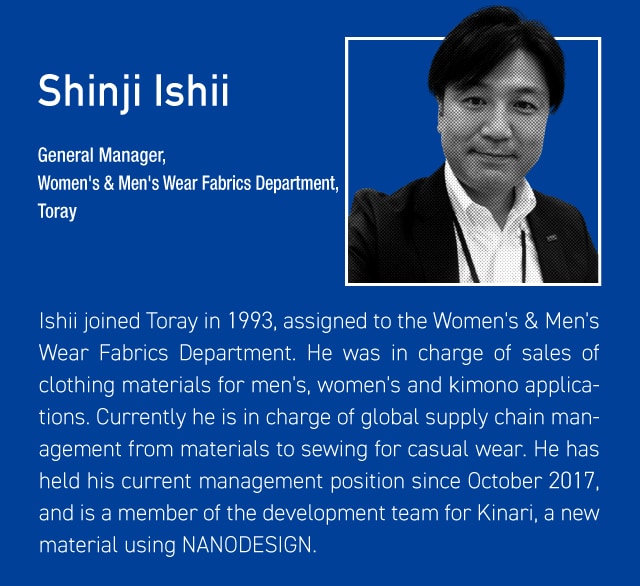
Silk has a luxurious image—dresses and kimono. From a consumer’s point of view, silk is a beautiful and comfortable material, but it’s delicate, difficult to handle, and expensive. Those of us in the synthetic fiber industry have been trying to fill this gap for half a century, trying to reproduce the advantages of silk with synthetic fibers since the 1960s. In a sense,
surpassing silk has been a dream project for those of us involved in the development and marketing of synthetic fibers, something we’ve all hoped to achieve one day. We’ve finally done it with Kinari.
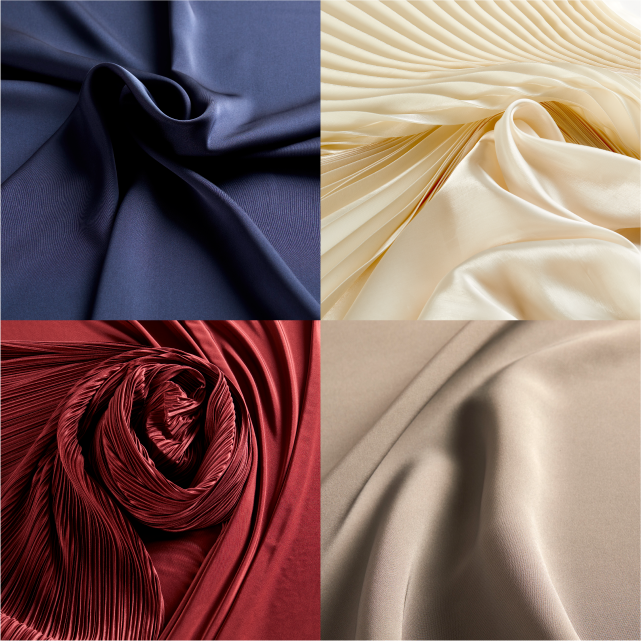
Kinari is a new textile material announced by Toray in October 2019. By mimicking the structure and performance of natural silk and combining them with our proprietary NANODESIGN™ technology, we have achieved a natural, high-quality gloss and lightweight feel while retaining the ease of handling of polyester.
──From a technical standpoint, how is it different from conventional polyester fibers?
Ishii: A basic technology called NANODESIGN™ played a decisive role in the development of Kinari.
I was in charge of kimono when I was in my twenties, and I thought hard about the unique properties of silk. It was technically difficult at the time, but when I learned about NANODESIGN™ in 2017, I thought this technology might really be able to produce a synthetic fiber that surpasses silk.
Masuda: NANODESIGN™ is a core technology that embodies the principles of Toray's synthetic fiber research, pursuing a material to its limit. Our work developing finer fibers led to the production of Toray's most important materials, like artificial leather and eyeglass cloth. NANODESIGN™ is built on technologies developed by our predecessors, and it has opened up a new frontier in synthetic fibers.
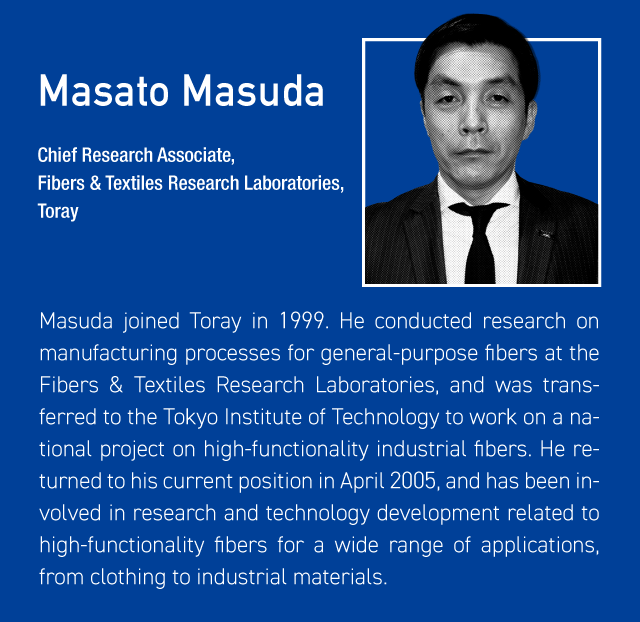
To make a long story short, we’ve known for quite some time that work on the cross-section of fibers can expand the range of functions and expressions of materials. But until recently, we had to deal with a lot of restrictions on both the thickness and shape of the cross-section, because fibers were designed based on the shape of the discharge hole for the polymer compound that makes up the raw material of synthetic fibers.
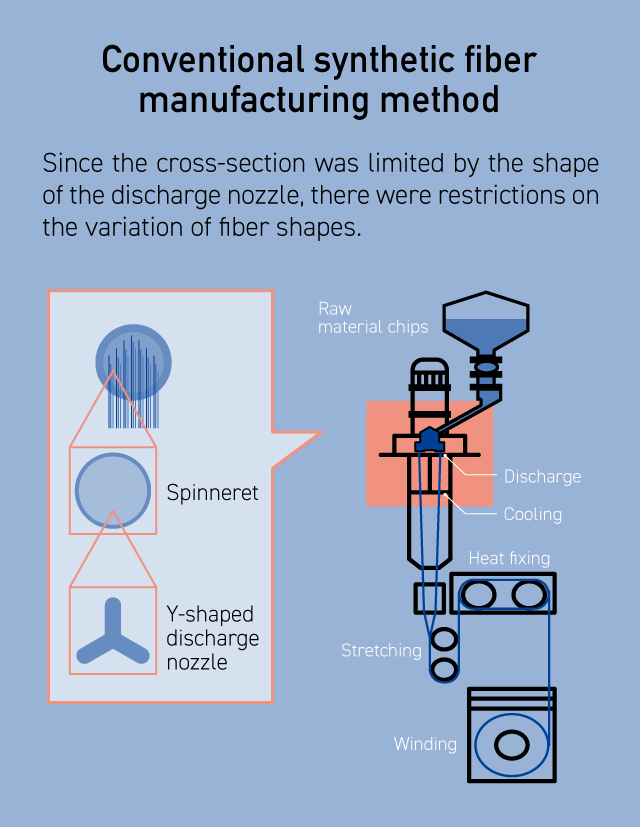
That’s when we decided to fundamentally change our approach to cross-sectional control. After a lot of trial and error, we found a spinning method that divided the polymer to its absolute limit, so we could control the fiber’s cross-section freely, without being bound by the shape of the discharge nozzle. In a sense, making raw materials into extremely small points increased the resolution, so we had more freedom in designed the material’s cross-section.
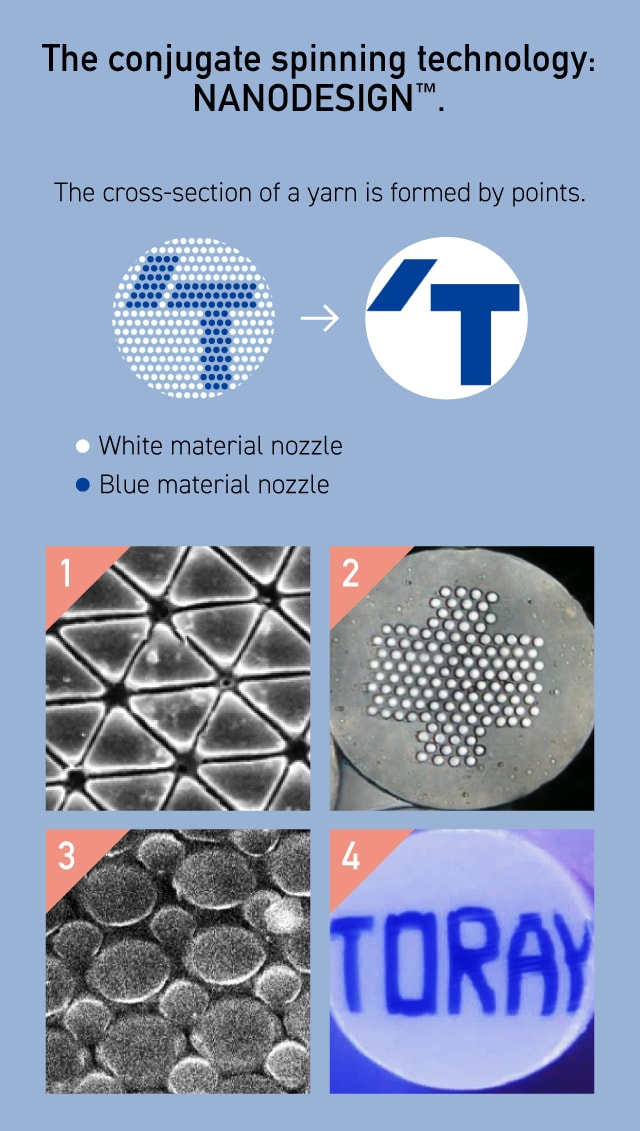
(1) Composite fiber with a triangular cross-section (2) Cross-section with multiple raw materials arranged (3) Enlarged photograph of a part of the composite fiber (4) Designing with dots, complex designs like these are possible
NANODESIGN™ literally means designing fibers at the nanometer level. When you can control the shape of the material at this fine level of detail, new variations in function, touch and appearance become possible.
Suzuki: Those of us who develop textiles and processing technology have always asked people like Mr. Masuda and his team to make yarns with particular functions. But the technology limited what we could do.
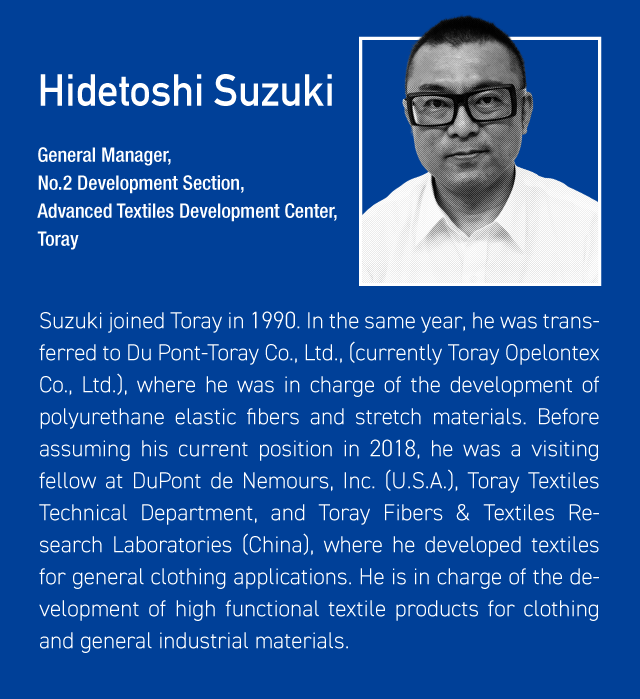
The situation has changed dramatically with NANODESIGN™. As the degree of leeway has increased, we are now being required more than ever to create new functions by weaving and knitting.
There’s more pressure, but it’s rewarding. Kinari is an especially successful example. The precise design of the fiber material is reflected in the characteristics of the fabric, leading to a new aesthetic and new functions.
■ Breakthroughs over 50 years
──What was your approach to producing ‘silkiness’ in Kinari?
Ishii:People have been working on a silk-like material using polyester since the 1960s. But reproducing the luster and fluffiness of natural silk was a hurdle that we just couldn't clear.
Masuda:When Mr. Ishii asked me to create a silky material that had never existed before, I approached it as a researcher. I asked myself, “What is the difference between silk and synthetic fibers?” What are the physical advantages that you’re trying to express with this material? Before you figure out an approach, you need to understand the goal.
Suzuki:If you look at the cross-section of a natural silk fabric, you will see that the main component of silk, a single thread called a fibroin, is oriented in a random direction, and there are tiny gaps there. Silkworms shake their head in a figure-eight motion and spit out thread. This, combined with the twisting of the yarn, creates a gap between the fibers. It’s really quite a miracle.
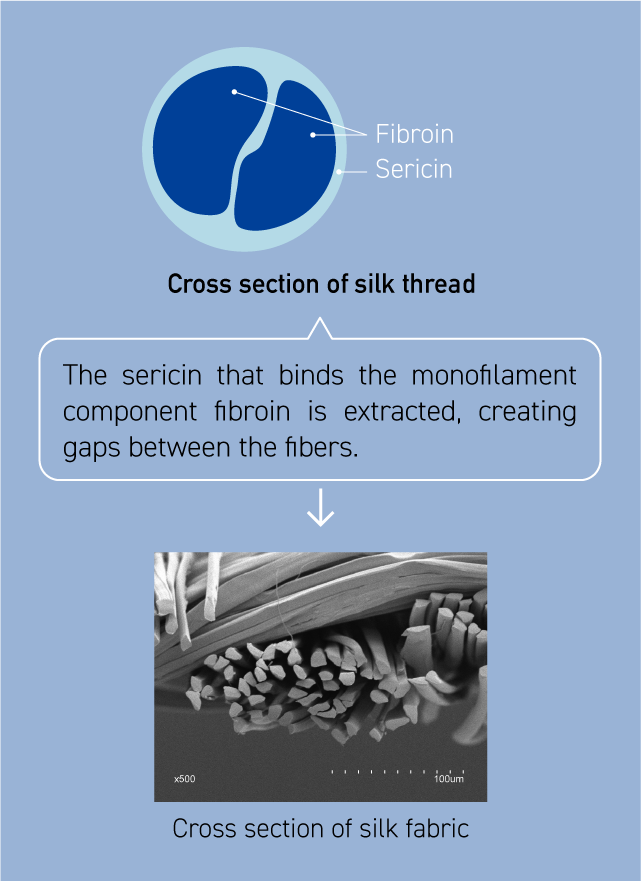
In conventional polyester, however, each yarn is oriented in the same direction, and there are not many gaps. That’s why the surface was flat, and light reflection became so strong that it has a very artificial luster. How we can create a random twisting structure? That was the direction we aimed for in the development of Kinari, and it was a major challenge for us.
──How did you do it?
Suzuki:In Kinari's original yarn, we use NANODESIGN™ to arrange two types of polymers with different heat shrinkage rates. We weave or knit the yarn, then heat it, and the difference in heat shrinkage causes twisting. Then we dissolve the bond that holds the two polymers together, and it splits into two curled threads with tiny gaps, or microvoids between them.
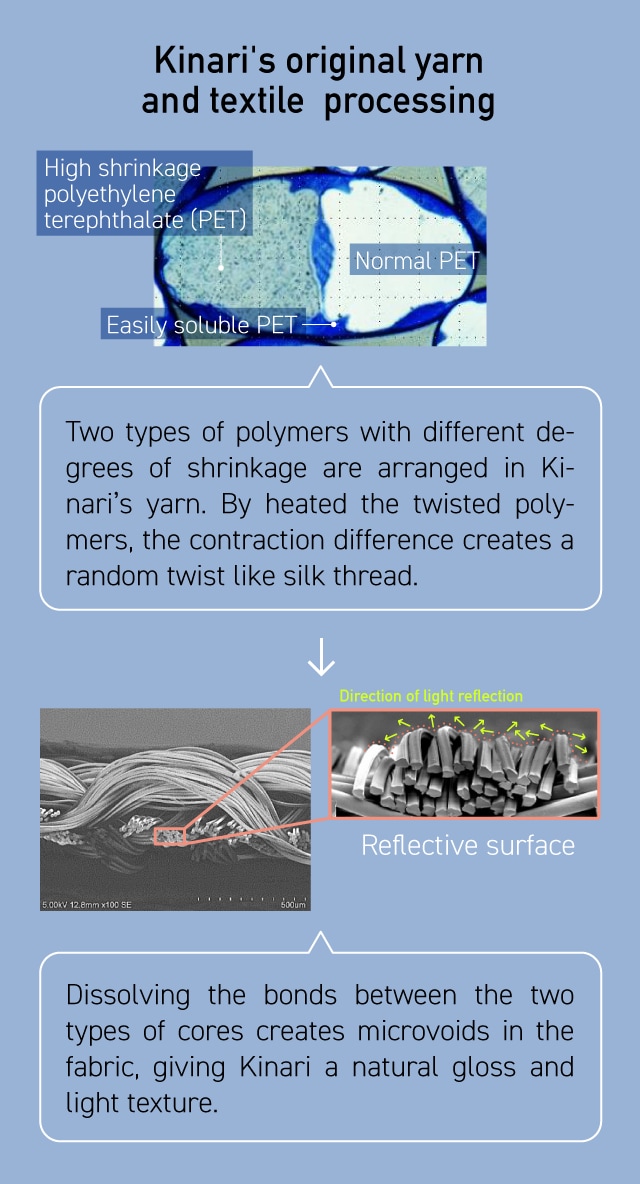
Ishii: Natural silk makes a distinct sound called kinunari in Japanese because of these microvoids. That’s where we got the name, "Kinari." In fact, when you touch Kinari, it makes the same silky sound, or “scroop” that natural silk does.
Masuda: Microvoids create all of these important characteristics of silk: the natural, elegant gloss, fluffiness, and sound.
Toray brought together a wide array of technologies to make this breakthrough, and it needed the unique expertise of each and every researcher and developer in this processing technology, all built upon past research and technical development. Toray’s decades of research and development came together in the surprise development of Kinari.
■Turning knowledge into a product
──Toray has been researching silky synthetic fibers for half a century, hasn’t it? What was it that made it work this time?
Ishii: Toray originally had a team structure in place in which research, development, and sales worked together to develop products, and we would get together about once a month for a meeting.
During the meeting, Mr. Masuda talked about the great potential of NANODESIGN™. This made me think that it might be possible to produce a silky synthetic fiber, something that’s been a dream of mine for quite some time, and the development and processing took off from there.
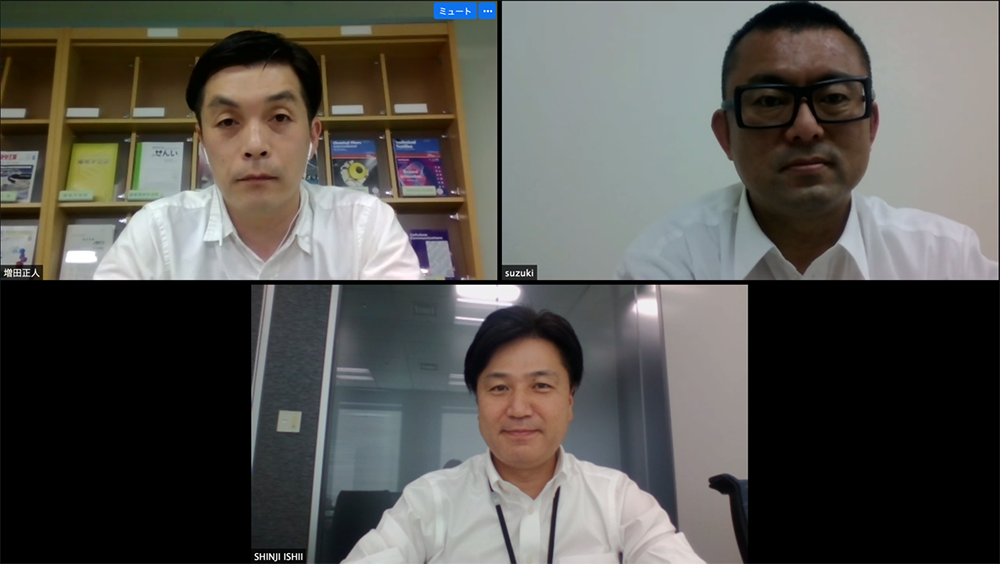
Masuda: It was really just a coincidence. As I was researching silk, I thought back to my work studying the properties of polyester, and I had discovered those by accident when I was researching a completely different material. I tried it, and it worked (laughs).
When try to research and develop something in particular, we might get it right half the time. Maybe less. But we always learn something along the way. The way we use those spinoffs makes the difference between success and failure down the line.
──You’re a member of the Advanced Textiles Development Center (ATD Center). What was the Center’s role in the development of Kinari?
Suzuki: The ATD Center is made up of two development areas: the First Development Section, where we do deep research into basic technologies and create new technologies, and the Second Development Section, where we develop high value-added materials and products and work on evaluation technologies.
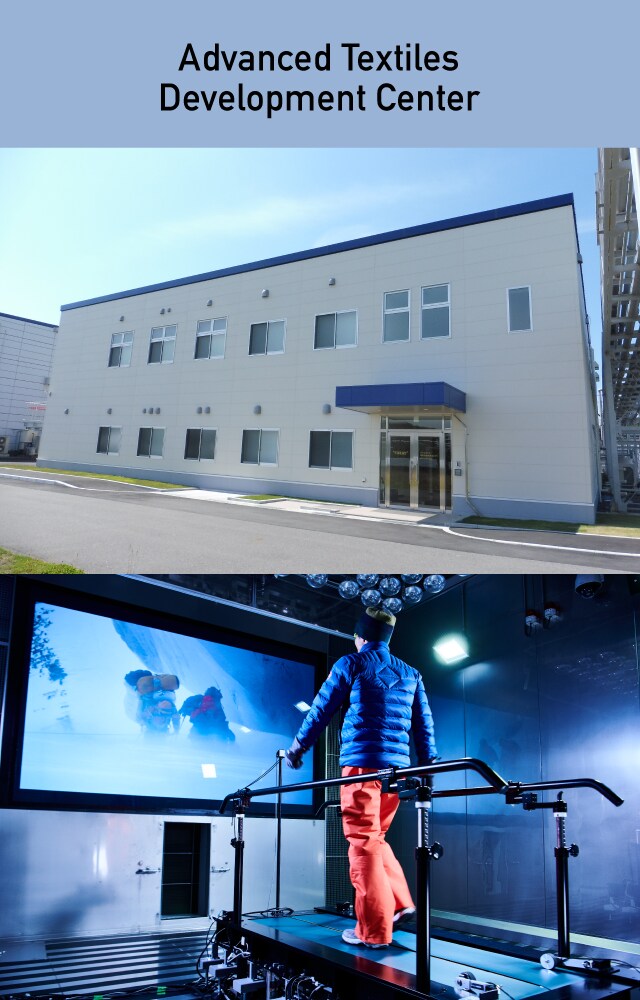
This is the base of operations for developing textile processing of Toray fibers. In addition to facilities for making fabric samples, the development base is also equipped with the latest in evaluation and analysis technologies, including an artificial weather room that reproduces all kinds of weather conditions and a system that quantifies human movements.
While we were developing Kinari, we got the raw yarns from the Fibers & Textiles Research Laboratories where Mr. Masuda is working, and took them to the next stage of textile processing to create fabric samples. We also ran the evaluations.
As an example of the kind of evaluations we do, it’s difficult to sew with silk thread, because it ripples when you use a sewing machine. Kinari is a lot easier to process and sew because it ripples and wrinkles less than silk thread or conventional polyester material.
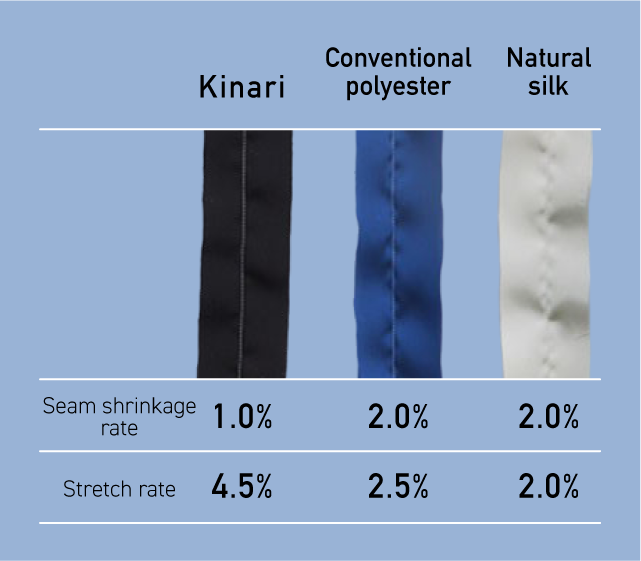
The ATD Center also needs to put numbers on these evaluations so we can measure them objectively. How does it stack up against other materials? We get a sense of the breadth and strength of design across the whole field of clothing materials with this data. Thinking about good applications for a material is another big part of the job.
──There are a lot of different kinds of expertise here: product development, materials, processing. We get new materials like Kinari when we can bring that expertise together.
Masuda: Exactly. Toray encourages “curiosity-driven research,” so researchers have time to conduct their own independent research, and I often talk with young lab members about what kind of fabrics they want to see in clothes. For example, we might talk about the costumes from “Back to the Future” or in anime, and I’ll ask them what kind of yarns we’d need to design for those costumes. We’ve developed a lot of ideas from those discussions and developed them into core technologies.
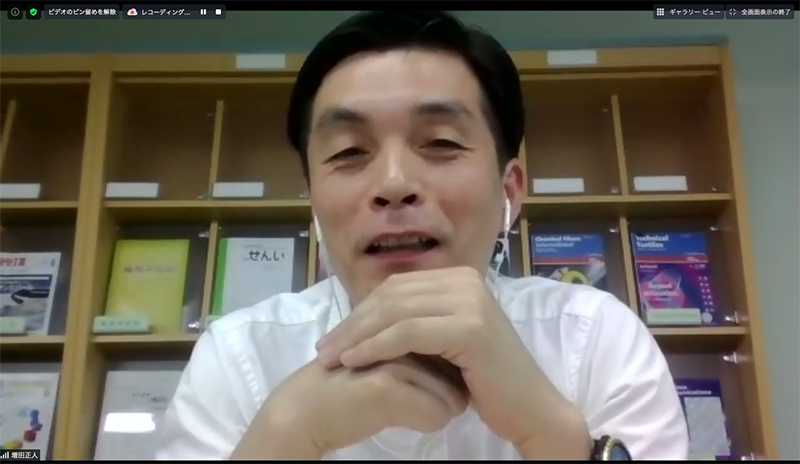
Suzuki: TSome of our younger researchers at the ATD Center are doing the same. There’s a lot of research going into the kinds of suits and clothes you see in movies and anime (laughs).
Just like in Mr. Masuda’s research, combining ideas and techniques is important in textile processing. Even if we feel like we’ve perfected the individual technologies, changing the combination of those technologies can produce a totally new fabric. It’s not just polyester, we have a lot of other synthetic fibers to work with, like acrylic, nylon, polyphenylene sulfide (PPS), fluorine fiber, and carbon fiber. Using processing techniques for one material might lead to a discovery in another material. There’s a trend these days of finding a new market by collaborating with other industries.
■What kind of future will synthetic fibers create?
Ishii: Listening to these two researchers, it struck me once again that Toray's R&D is really supported by geeks (laughs). It’s one of Toray's major strengths.
On my side of things, in sales, our skill comes in taking that geeky passion and passing it on to customers as solutions for their needs. That’s why it’s important to be able to work with these technologies in ways that match the expectations of society, working with these materials to follow social trends.
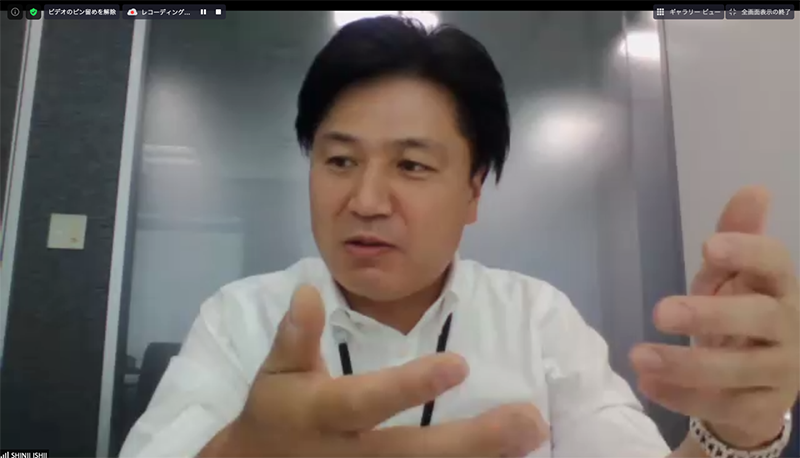
When we’re developing a new fiber, we need to keep the customer in mind and think about how they’ll use it. Otherwise, we risk becoming detached from the demands of the real world.
Toray is the only manufacturer that develops polymers, yarns, and textiles in an integrated manner to meet those demands. Salespeople need to be a liaison between the technology and the market, and that’s also one of Toray's strengths.
──I want to ask each of you: what kind of future do you want to create with these new synthetic materials?
Suzuki: Environmental sustainability and SDGs are absolutely essential. We also have the uniquely Japanese problem of a rapidly aging society. What can we do for older people who are losing muscle strength and other physical functions in our hot, humid climate? How can we make life more comfortable while dealing with threats like infectious disease? As material manufacturers, those are the kinds of things we need to be thinking about. And we need to pay attention to consumers’ feedback, avoid becoming too blinkered and self-centered as engineers.
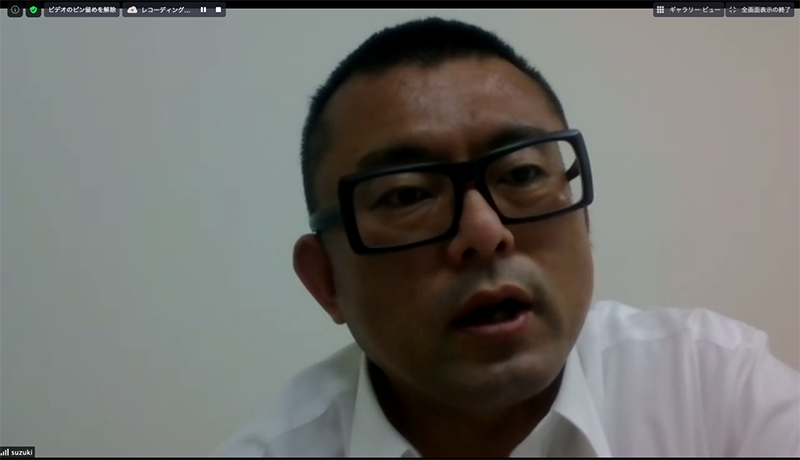
Ishii: Right, protecting human lives is the important role for us going forward. Just like the COVID-19 outbreak, we’re seeing more natural disasters, heat waves and heavy rain, and our lives are becoming more tense and anxious. We really need to think about ways that our materials can alleviate that anxiety and maintain a comfortable lifestyle for people.
Masuda: I agree. More than that, I personally want to work on materials that can achieve those goals in multiple ways. Kinari does this, and the futuristic clothes we see in movies do this too, balancing all these functions while looking beautiful. I want to make materials that have functional beauty. Materials that are not just beautiful, but that are more comfortable through use. I want to increase the number of uses for these materials and the ways they can enrich our lives using technologies like NANODESIGN™. As a materials manufacturer, I believe that creating the future means supporting society and people's daily life.
Produced by: NewsPicks Brand Design
Edited by: Koji Uno
Written by: Tetsuya Saito
Design by: Tomoka Kunihiro
